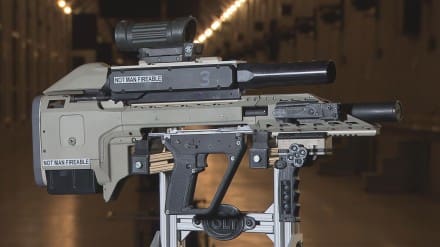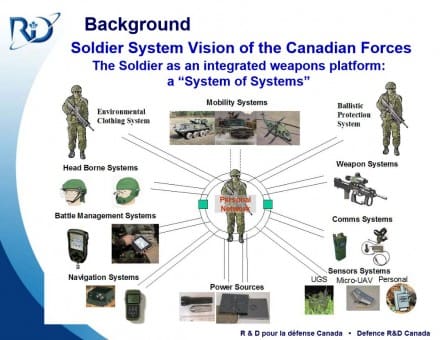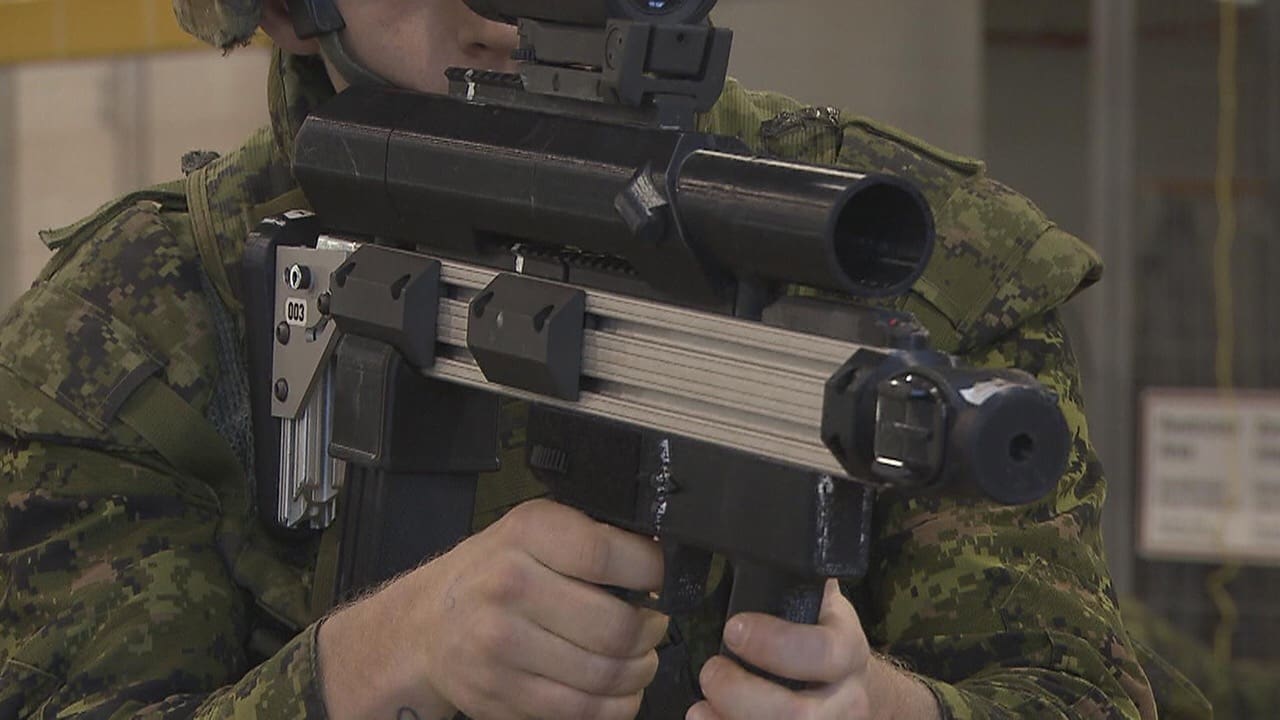Several countries (including the US) have worked on future weapon systems that combine an air burst subcomponent and a personal defense weapon subcomponent. Soldier Integrated Precision Effects Systems is Canada’s effort. Working with Colt Canada, they are going all out, incorporating telescoping cased ammunition as well as a powered rail system.
The SIPES demonstrator you see here isn’t the actual weapon that will be fielded but more of a tech development effort. In fact, you’ll notice in the photo above that this particular example is meant for firing from a test fixture. SIPES is latest effort of the Small Arms Replacement Project II which began in 2007 and overall, Canada expects to spend about $1 Billion to upgrade its small arms capability. As you can see, small arms is an import system in the Canadian Soldier ‘System of Systems’.
Below is the Defence Research and Development Canada press release.
More firepower, improved accuracy and smart integrated accessories that connect to command and control networks are the headline features of the new integrated assault rifle concept that Defence Research and Development Canada (DRDC) and Colt Canada have developed for the Canadian Armed Forces (CAF).
The prototype, in development since 2009 through the Soldier Integrated Precision Effects Systems (SIPES) project, includes a firing mechanism to shoot lightweight cased telescoped ammunition, a secondary effects module for increased firepower and a NATO standard power and data rail to integrate accessories like electro-optical sights and position sensors.
In order to support the multi-role nature of the weapon, the prototype’s secondary effects module features the ability to install either a three round 40 mm grenade launcher, or a 12-gauge shotgun. When optimized, the integrated weapon prototype could weigh less than a C7 equipped with a M203 grenade launcher, reducing the burden on soldiers.
“In the medium term, this weapon concept represents a lethal, flexible general-purpose platform,” said Lieutenant-Colonel Serge Lapointe, from the Soldier Systems group in Director Land Requirements – Soldier Systems (DLR 5) of the Canadian Army. “It will be able to operate in all theatres of operations in the most complex terrain including urban areas, mountains, jungles, deserts and the Arctic.”
The development of the weapon prototype posed a considerable challenge. DRDC scientists analyzed advanced material technologies that could replace the metal used in heavy components. The lightweight case telescoped ammunition was tested extensively with the support of the Munitions Experimental Test Centre in Valcartier, Quebec to assess its long-term aging behaviour.
Scientists also studied how to increase the rifle’s accuracy using technology that can automatically detect targets and assist with engaging them. Questions related to the sensors needed to accurately geo-locate targets for target data sharing were also investigated.
How the soldier interacts with the weapon was also the subject of numerous human factor trials. Ergonomic and weapon prototype handling tests were performed by Human Systems Inc., under the supervision of DRDC scientists, with CAF soldiers from military bases in Petawawa and Edmonton. The testing was crucial to developing optimal design criteria to meet the CAF’s needs for the Small Arms Modernization project.
In addition, lessons learned by both DRDC personnel and the CAF during their deployment in Afghanistan revealed critical elements that informed the prototype weapon development process with respect to its design and functionality.
“The results of the first phase of the project have shown that DRDC expertise can be used to provide the Canadian Armed Forces with solid scientific data so they can make more informed decisions for their major acquisition projects,” said Dr. Guy Vézina, the Director General for S&T Army, DRDC.
The new weapon prototype is a promising development for the soldier of the future. The integration of electronic components will allow soldiers to generate or receive data from the command and control network. In the next phase of development, automated target detection and assisted target engagement will be the subject of an in-depth study in the Future Small Arms Research (FSAR) project.
Finally, the development of the integrated weapon prototype and the continuing analysis of promising technologies should facilitate the acquisition of the next generation of small arms by the CAF. The data collected and the analyses documented so far by DRDC scientists will be used in conjunction with the data and analyses that will be generated in the FSAR project to develop the technical criteria that will form part of the statement of operational requirement documentation for the CAF Small Arms Modernization project.
Photos by Jocelyn Tessier DRDC
Tags: Canada






Everyone knows the most important part in creating a new weapons platform is to make it look cool — this fails.
On a more serious note, it’ll be interesting to see what comes of this program’s future. There seems, to me at least, to be a reinvigorated push for programs that remind me of some of the stuff the FF Army program was putting out.
For sure. I was really hoping the US Army would have adopted the HK M8… combined with new camo and new plate carriers, we would’ve looked like Starship Troopers!
*XM8
I’m pretty sure the mobile infantry never had to worry about their guns melting.
Thanks Mick. Now I’ll have that song in my head all day. Thanks for that.
Know what would really be awesome though? Having boots. Temperate, cold weather or arctic, any type of boots really. When we can’t supply troops with boots, uniforms, or other basic gear, we really need to take a step back from the drawing board. Sending soldiers on winter exercises without winter footwear is downright maddening and dangerous. Having shacks that have been condemned due to water damage and black mould but are somehow still used is a problem that can and should be fixed. We’re a small budget army, let the heavyweights deal with the R&D for the weapon of the future and let’s piggyback off of it. Given the other “great successes” to come out of DLR (the small pack, CTS Ruck, Tac Vest etc) as well as the inability to contract everything from trucks to boots to a Tac Vest replacement, I have very little hope for the “boots on the ground” seeing any of this kit unless there are major shakeups at higher levels.
https://soldiersystems.net/2014/04/01/canadian-army-land-operations-temperate-boot-program-soldiers-can-keep-old-boots-need-cos-permission-wear/
Paul, I’m not aware of the new boots being issued to anyone. Everyone I know has had to go out and buy their own boots because the system has failed us yet again.
Preaching to the choir dude.
I was on the base where the trials for these boots were being done. Many were complaining that even after light range wear, the boots were falling apart. Again, the CAF was stuck with selecting “the best of the garbage pile”. This trial was conducted in late 2013 and I have yet to see a single pair of boots issued out to troops.
Troops on BMQ have asked me, as their staff, if their waterlogged, blistered, and in some case bleeding feet after having done nothing other than marching to their 3 square meals and some classroom lectures are normal (despite taking proper care of their feet, changing socks, foot powder etc) when they’ve been issued goretex cold weather boots only and its the middle of June.
Let’s not forget that the whole boot replacement process started before 2006 (and resulted in a ghastly CADPAT boot on trial which I own as a piece of curio or if I need to piss off an RSM who institutes an “issued boots only” policy). http://www.specwar.info/maskovaci-vzory/cadpat/14.jpg
https://soldiersystems.net/2010/04/26/canadians-testing-camo-boots/
While I agree with with everything you have said about the DLR mess, and our terrible kit-
Everyone I know that trialed those boots still wears them. Well, the two types that were picked. I am surprised, but I keep hearing how well they are holding up.
In the end I will be the judge of how useful they are, but they are almost certainly better than the “general purpose” boot we have now (not that I have any- I’ve been on a waiting list since 2013 for boots, and I’m an Infantryman that wears a standard size).
“When we can’t supply troops with boots, uniforms, or other basic gear, we really need to take a step back from the drawing board. Sending soldiers on winter exercises without winter footwear is downright maddening and dangerous.”
I don’t know where you’re based, or what your trade/unit is, but I just got sworn in in Jan, and had my initial kit issue in mid Jan, and they gave me EVERYTHING, including two pairs of the new Wet Weather Combat Boots, Mukluks, etc etc. Maybe I just lucked out at stores, but so far no one on my BMQ has complained about lack of kit issue
Until there is a major tech jump, this will be a bottomless pit. The OICW project couldn’t get the weight/bulk down to an acceptable level, although that was several years ago now. Ultimately OICW program seperated the “smart weapon,” now known as the SM25 (20mm computer controlled precision munition), from the carbine. Ultimately the hassel of carrying a second long arm, XM25, in conjuction with a dedicated carbine/rifle proved to be less cumbersome than the excess bulk of the OICW.
There are some things currently in the works that can help get weight down, polymer cased ammo for instance, but I’m not sure there is a solution to battery life, and other bulk/size issues surounding the dual weapons platform?
http://www.imfdb.org/images/thumb/b/bb/ZF-1_500.jpg/400px-ZF-1_500.jpg
Bravo.
For those who’d like to see it in action: https://www.youtube.com/watch?feature=player_detailpage&v=7jVsQToSfag#t=30
hey, what is that button on its side for? oh, I dont know….lets press it and find out….
It unleashes the 5th element….
Okay so a 3 shot over barrel 40mm grenade launcher. sounds like the Metal storm system but that company is defunct.
Cased telescoped ammo. The sounds like the US Army’s LSAT program Given the defence ties between the US and Canada Could they be shooting the same rounds as the LSAT?
I liked the idea of the 20mm grenade/munition they were playing around with the XM25. As long as you are creating a new weapon system, it would be a worth a shot to explore the possibilities of a new cartridge. In typical military fashion, almost no one would be issued anything but the most commonplace cartridges (HEDP and Practice) though.
Definitely echoing that a small, hand portable weapon system in addition to an already lightweight service carbine would be preferably, under the assumption that a decent holster was issued. The M320 design could be scaled well to fit a smaller cartridge, and more than one companies currently make holsters for it (Blue Force and S&S).
The XM25 fires a 25mm round.
The XM29 OCIW program utilized a 20mm round
I’m just surprised nobody has brought up “Aliens” yet…
Morita Smart Rifle.
a Mini14 with a Ithica 12 gauge in a muzzlelite Shell and a M60 muzzle break
The Aliens M41A “Pulse Rifle” would be slightly closer being described as “a 10 millimeter explosive tip light armor piercing caseless round with a 4 shot 30mm pump action grenade launcher.” In actuality a Thompson M1 with a cut down remington 870 and parts off a Spas 12
Why does this make me wanna say “Pew-pew-pew” when I see it?
I dont know, I think it looks more like the early version of this..
http://www.weaponreplica.com/tag/movie-guns/page/5/